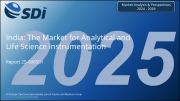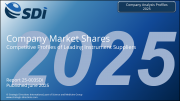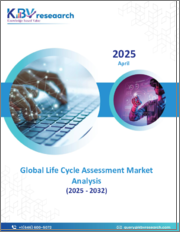
|
시장보고서
상품코드
1542404
세계의 생명과학 기기 시장 조사 보고서 : 산업 분석, 규모, 점유율, 성장, 동향, 예측(2024-2032년)Global Life Science Instrumentation Market Research Report - Industry Analysis, Size, Share, Growth, Trends and Forecast 2024 to 2032 |
||||||
생명과학 기기 시장의 세계 수요는 2024-2032년 연평균 6.64%의 CAGR로 2023년 691억 달러에서 2032년에는 거의 1,232억 5,000만 달러에 달할 것으로 추정됩니다.
생명과학 기기 시장에는 과학 연구, 실험실 진단 및 생명공학 응용을 위한 다양한 기기 및 장비가 포함됩니다. 이러한 장비는 생물학적 과정 연구, 생체 분자 분석, 유전체학, 단백질체학, 세포 생물학, 신약 개발 실험에 필수적입니다. 질량 분석, 유세포 분석, 차세대 염기서열 분석기(NGS), 현미경, 크로마토그래피 시스템 등 첨단 기술이 포함됩니다. 이러한 장비는 연구자, 임상의, 제약회사가 분자 및 세포 수준에서 생물학적 시스템을 탐색, 분석 및 이해하여 의료, 농업 및 환경 과학의 발전에 기여할 수 있도록 지원합니다.
시장 역학
개인 맞춤형 의료 및 정밀 의료 솔루션에 대한 수요가 증가하면서 세계 생명과학 기기 시장이 성장하고 있습니다. 생명과학 기기는 바이오마커 탐색, 유전자 검사, 분자진단에 중요한 역할을 하며, 환자 맞춤형 치료 및 맞춤 치료 계획의 개발을 촉진합니다. 정교한 기기를 통한 유전체학 및 단백질체학 기술의 발전은 헬스케어 산업 전반에 걸쳐 정밀의료 접근 방식으로의 전환을 가속화하고 있습니다. 또한, 제약 및 생명공학 분야에서 진행 중인 연구 개발 활동은 첨단 생명과학 기기에 대한 수요를 촉진하고 있습니다. 이러한 장비는 신약 개발, 개발 및 품질 관리 프로세스에 필수적이며, 새로운 치료법, 백신 및 생물학적 제제 혁신을 위한 노력을 뒷받침하고, NGS 및 하이스루풋 스크리닝 시스템과 같은 기술은 신약 개발 파이프라인을 가속화하고 전임상 및 임상 연구의 효율성을 향상시키는 데 도움을 주고 있습니다. 효율성을 향상시키는 데 도움을 주고 있습니다.
또한, 전 세계적으로 만성 질환과 감염성 질환의 확산, 환경 문제의 증가는 생명과학 기기 시장에 대한 투자를 촉진하고 있습니다. 진단 실험실과 연구 기관은 질병 감시, 환경 모니터링, 역학 조사를 위해 이러한 장비를 사용하고 있으며, COVID-19 전염병은 신속한 진단 도구와 분자 테스트 플랫폼의 중요성을 강조하고 전염병 대비 및 대응 노력을위한 PCR 시스템, 항원 분석 및 기타 생명과학 기기의 채택을 촉진하고 있습니다. 그러나 정교한 장비를 구입하고 유지하는 데 드는 높은 비용은 특히 신흥 경제권의 소규모 실험실과 연구 시설에 재정적 어려움을 초래할 수 있습니다.
이 조사 보고서는 Porter's Five Forces 모델, 시장 매력도 분석, 밸류체인 분석을 다룹니다. 이러한 도구는 산업 구조를 명확하게 파악하고 세계 수준에서 경쟁의 매력을 평가하는 데 도움이 될 수 있습니다. 또한 이러한 도구는 세계 생명과학 기기 시장의 각 부문을 포괄적으로 평가할 수 있습니다. 생명과학 계측기 산업의 성장과 동향은 이 조사에 대한 전체적인 접근 방식을 제공합니다.
시장 세분화
생명과학 기기 시장 보고서의 이 섹션에서는 국가 및 지역별 부문에 대한 상세한 데이터를 제공하여 전략 담당자가 각 제품 또는 서비스의 타겟층을 식별하고 향후 기회를 파악할 수 있도록 지원합니다.
기술별
- 분광법
- 크로마토그래피
- 중합효소 연쇄 반응
- 차세대 시퀀서
- 임상 화학 분석기
- 유세포 분석
- 면역 측정
- 기타
용도별
- 조사 용도
- 임상 응용
- 기타
최종사용자별
- 연구기관
- 제약 및 생명공학 기업
- 진단연구소
- 기타
지역 분석
이 섹션에서는 북미, 유럽, 아시아태평양, 라틴아메리카, 중동 및 아프리카의 생명과학 기기 시장의 현재와 미래 수요에 대한 지역별 전망을 설명합니다. 또한, 모든 주요 지역의 개별 응용 분야에 대한 수요, 추정 및 예측에 초점을 맞추고 있습니다.
요청이 있으시면 저희에게 연락 주시기 바랍니다. 당사의 조사팀은 고객의 요구에 따라 맞춤형 보고서를 제공할 수 있습니다.
목차
제1장 서문
제2장 주요 요약
- 시장 하이라이트
- 세계 시장 현황
제3장 생명과학 기기 - 산업 분석
- 소개 : 시장 역학
- 시장 성장 촉진요인
- 시장 성장 억제요인
- 시장 기회
- 업계 동향
- Porter's Five Forces 분석
- 시장 매력 분석
제4장 밸류체인 분석
- 밸류체인 분석
- 원자재 분석
- 원자재 리스트
- 원자재 제조업체 리스트
- 주요 원자재 가격 동향
- 잠재적 바이어 리스트
- 마케팅 채널
- 직접 마케팅
- 간접 마케팅
- 마케팅 채널 발전 동향
제5장 생명과학 기기 세계 시장 분석 : 기술별
- 개요 : 기술별
- 과거 및 예측 데이터 분석 : 기술별
- 분광법
- 크로마토그래피
- 중합효소 연쇄 반응
- 차세대 시퀸싱
- 임상화학 분석기
- 유세포 분석
- 면역측정
- 기타
제6장 생명과학 기기 세계 시장 분석 : 용도별
- 개요 : 용도별
- 과거 및 예측 데이터 분석 : 용도별
- 조사 용도
- 임상 용도
- 기타
제7장 생명과학 기기 세계 시장 분석 : 최종사용자별
- 개요 : 최종사용자별
- 과거 및 예측 데이터 분석 : 최종사용자별
- 연구기관
- 제약·바이오테크놀러지 기업
- 진단 연구소
- 기타
제8장 생명과학 기기 세계 시장 분석 : 지역별
- 지역별 전망
- 소개
- 북미 판매량 분석
- 개요, 실적과 예측
- 북미 : 부문별
- 북미 국가별
- 미국
- 캐나다
- 멕시코
- 유럽 판매량 분석
- 개요, 실적과 예측
- 유럽 부문별
- 유럽 국가별
- 영국
- 프랑스
- 독일
- 이탈리아
- 러시아
- 기타 유럽
- 아시아태평양 판매량 분석
- 개요, 실적과 예측
- 아시아태평양 부문별
- 아시아태평양 국가별
- 중국
- 인도
- 일본
- 한국
- 호주
- 동남아시아
- 기타 아시아태평양
- 라틴아메리카 판매량 분석
- 개요, 실적과 예측
- 라틴아메리카 부문별
- 라틴아메리카 국가별
- 브라질
- 아르헨티나
- 페루
- 칠레
- 기타 라틴아메리카
- 중동 및 아프리카 판매량 분석
- 개요, 실적과 예측
- 중동 및 아프리카 부문별
- 중동 및 아프리카 국가별 리스트
- 사우디아라비아
- 아랍에미리트
- 이스라엘
- 남아프리카공화국
- 기타 중동 및 아프리카
제9장 생명과학 기기 제조업체 경쟁 상황
- 생명과학 기기 시장 경쟁
- 제휴, 협력, 합의
- 인수합병
- 신제품 발표
- 기타 개발
제10장 기업 개요
- 상위 기업의 시장 점유율 분석
- 시장 집중도
- Danaher
- Thermo Fisher Scientific Inc.
- Merck KGaA
- Bio-Rad Laboratories Inc.
- Agilent Technologies Inc.
- Illumina Inc.
- PerkinElmer Inc.
- BD
- Bruker
- Hitachi High-Tech Corporation
The global demand for Life Science Instrumentation Market is presumed to reach the market size of nearly USD 123.25 Billion by 2032 from USD 69.1 Billion in 2023 with a CAGR of 6.64% under the study period 2024-2032.
The life science instrumentation market encompasses various instruments and devices in scientific research, laboratory diagnostics, and biotechnology applications. These instruments are essential for studying biological processes, analyzing biomolecules, and conducting genomics, proteomics, cell biology, and drug discovery experiments. It includes advanced technologies like mass spectrometry, flow cytometry, next-generation sequencing (NGS), microscopy, chromatography systems, and more. These instruments enable researchers, clinicians, and pharmaceutical companies to explore, analyze, and understand biological systems at molecular and cellular levels, contributing to advancements in healthcare, agriculture, and environmental sciences.
MARKET DYNAMICS
The rising demand for personalized medicine and precision healthcare solutions propels the global life science instrumentation market. Life science instruments play a vital role in biomarker discovery, genetic testing, and molecular diagnostics, facilitating the development of targeted therapies & personalized treatment plans for patients. Advances in genomics and proteomics technologies, enabled by sophisticated instrumentation, are accelerating the shift towards precision medicine approaches across the healthcare industry. Moreover, ongoing research and development activities in the pharmaceutical & biotechnology sectors drive the demand for advanced life science instrumentation. These instruments are indispensable for drug discovery, development, and quality control processes, supporting efforts to innovate new therapies, vaccines, and biologics. Technologies such as NGS and high-throughput screening systems are instrumental in accelerating drug discovery pipelines and improving preclinical and clinical research efficiency.
Furthermore, the growing prevalence of chronic diseases & infectious diseases and environmental challenges worldwide fuel investments in the life science instrumentation market. Diagnostic laboratories and research institutions rely on these instruments for disease surveillance, environmental monitoring, and epidemiological studies. The COVID-19 pandemic has underscored the significance of rapid diagnostic tools and molecular testing platforms, driving the adoption of PCR systems, antigen assays, and other life science instruments for pandemic preparedness and response efforts. However, the high cost associated with acquiring and maintaining sophisticated instrumentation may pose financial challenges for small laboratories and research facilities, particularly in emerging economies.
The research report covers Porter's Five Forces Model, Market Attractiveness Analysis, and Value Chain analysis. These tools help to get a clear picture of the industry's structure and evaluate the competition attractiveness at a global level. Additionally, these tools also give an inclusive assessment of each segment in the global market of Life Science Instrumentation. The growth and trends of Life Science Instrumentation industry provide a holistic approach to this study.
MARKET SEGMENTATION
This section of the Life Science Instrumentation market report provides detailed data on the segments at country and regional level, thereby assisting the strategist in identifying the target demographics for the respective product or services with the upcoming opportunities.
By Technique
- Spectroscopy
- Chromatography
- Polymerase Chain Reaction
- Next-generation Sequencing
- Clinical Chemistry Analyzers
- Flow Cytometry
- Immunoassays
- Others
By Application
- Research Applications
- Clinical Applications
- Others
By End-user
- Research Institutes
- Pharmaceutical & Biotechnology Companies
- Diagnostic Laboratories
- Others
REGIONAL ANALYSIS
This section covers the regional outlook, which accentuates current and future demand for the Life Science Instrumentation market across North America, Europe, Asia-Pacific, Latin America, and Middle East & Africa. Further, the report focuses on demand, estimation, and forecast for individual application segments across all the prominent regions.
The research report also covers the comprehensive profiles of the key players in the market and an in-depth view of the competitive landscape worldwide. The major players in the Life Science Instrumentation market include Danaher, Thermo Fisher Scientific Inc., Merck KGaA, Bio-Rad Laboratories Inc., Agilent Technologies Inc., Illumina Inc., PerkinElmer Inc., BD, Bruker, Hitachi High-Tech Corporation. This section consists of a holistic view of the competitive landscape that includes various strategic developments such as key mergers & acquisitions, future capacities, partnerships, financial overviews, collaborations, new product developments, new product launches, and other developments.
In case you have any custom requirements, do write to us. Our research team can offer a customized report as per your need.
TABLE OF CONTENTS
1. PREFACE
- 1.1. Report Description
- 1.1.1 Objective
- 1.1.2 Target Audience
- 1.1.3 Unique Selling Proposition (USP) & offerings
- 1.2. Research Scope
- 1.3. Research Methodology
- 1.3.1 Market Research Process
- 1.3.2 Market Research Methodology
2. EXECUTIVE SUMMARY
- 2.1. Highlights of Market
- 2.2. Global Market Snapshot
3. LIFE SCIENCE INSTRUMENTATION - INDUSTRY ANALYSIS
- 3.1. Introduction - Market Dynamics
- 3.2. Market Drivers
- 3.3. Market Restraints
- 3.4. Opportunities
- 3.5. Industry Trends
- 3.6. Porter's Five Force Analysis
- 3.7. Market Attractiveness Analysis
- 3.7.1 Market Attractiveness Analysis By Technique
- 3.7.2 Market Attractiveness Analysis By Application
- 3.7.3 Market Attractiveness Analysis By End-user
- 3.7.4 Market Attractiveness Analysis By Region
4. VALUE CHAIN ANALYSIS
- 4.1. Value Chain Analysis
- 4.2. Raw Material Analysis
- 4.2.1 List of Raw Materials
- 4.2.2 Raw Material Manufactures List
- 4.2.3 Price Trend of Key Raw Materials
- 4.3. List of Potential Buyers
- 4.4. Marketing Channel
- 4.4.1 Direct Marketing
- 4.4.2 Indirect Marketing
- 4.4.3 Marketing Channel Development Trend
5. GLOBAL LIFE SCIENCE INSTRUMENTATION MARKET ANALYSIS BY TECHNIQUE
- 5.1. Overview By Technique
- 5.2. Historical and Forecast Data Analysis By Technique
- 5.3. Spectroscopy Historic and Forecast Sales By Regions
- 5.4. Chromatography Historic and Forecast Sales By Regions
- 5.5. Polymerase Chain Reaction Historic and Forecast Sales By Regions
- 5.6. Next-generation Sequencing Historic and Forecast Sales By Regions
- 5.7. Clinical Chemistry Analyzers Historic and Forecast Sales By Regions
- 5.8. Flow Cytometry Historic and Forecast Sales By Regions
- 5.9. Immunoassays Historic and Forecast Sales By Regions
- 5.10. Others Historic and Forecast Sales By Regions
6. GLOBAL LIFE SCIENCE INSTRUMENTATION MARKET ANALYSIS BY APPLICATION
- 6.1. Overview By Application
- 6.2. Historical and Forecast Data Analysis By Application
- 6.3. Research Applications Historic and Forecast Sales By Regions
- 6.4. Clinical Applications Historic and Forecast Sales By Regions
- 6.5. Others Historic and Forecast Sales By Regions
7. GLOBAL LIFE SCIENCE INSTRUMENTATION MARKET ANALYSIS BY END-USER
- 7.1. Overview By End-user
- 7.2. Historical and Forecast Data Analysis By End-user
- 7.3. Research Institutes Historic and Forecast Sales By Regions
- 7.4. Pharmaceutical & Biotechnology Companies Historic and Forecast Sales By Regions
- 7.5. Diagnostic Laboratories Historic and Forecast Sales By Regions
- 7.6. Others Historic and Forecast Sales By Regions
8. GLOBAL LIFE SCIENCE INSTRUMENTATION MARKET ANALYSIS BY GEOGRAPHY
- 8.1. Regional Outlook
- 8.2. Introduction
- 8.3. North America Sales Analysis
- 8.3.1 Overview, Historic and Forecast Data Sales Analysis
- 8.3.2 North America By Segment Sales Analysis
- 8.3.3 North America By Country Sales Analysis
- 8.3.4 United States Sales Analysis
- 8.3.5 Canada Sales Analysis
- 8.3.6 Mexico Sales Analysis
- 8.4. Europe Sales Analysis
- 8.4.1 Overview, Historic and Forecast Data Sales Analysis
- 8.4.2 Europe By Segment Sales Analysis
- 8.4.3 Europe By Country Sales Analysis
- 8.4.4 United Kingdom Sales Analysis
- 8.4.5 France Sales Analysis
- 8.4.6 Germany Sales Analysis
- 8.4.7 Italy Sales Analysis
- 8.4.8 Russia Sales Analysis
- 8.4.9 Rest Of Europe Sales Analysis
- 8.5. Asia Pacific Sales Analysis
- 8.5.1 Overview, Historic and Forecast Data Sales Analysis
- 8.5.2 Asia Pacific By Segment Sales Analysis
- 8.5.3 Asia Pacific By Country Sales Analysis
- 8.5.4 China Sales Analysis
- 8.5.5 India Sales Analysis
- 8.5.6 Japan Sales Analysis
- 8.5.7 South Korea Sales Analysis
- 8.5.8 Australia Sales Analysis
- 8.5.9 South East Asia Sales Analysis
- 8.5.10 Rest Of Asia Pacific Sales Analysis
- 8.6. Latin America Sales Analysis
- 8.6.1 Overview, Historic and Forecast Data Sales Analysis
- 8.6.2 Latin America By Segment Sales Analysis
- 8.6.3 Latin America By Country Sales Analysis
- 8.6.4 Brazil Sales Analysis
- 8.6.5 Argentina Sales Analysis
- 8.6.6 Peru Sales Analysis
- 8.6.7 Chile Sales Analysis
- 8.6.8 Rest of Latin America Sales Analysis
- 8.7. Middle East & Africa Sales Analysis
- 8.7.1 Overview, Historic and Forecast Data Sales Analysis
- 8.7.2 Middle East & Africa By Segment Sales Analysis
- 8.7.3 Middle East & Africa By Country Sales Analysis
- 8.7.4 Saudi Arabia Sales Analysis
- 8.7.5 UAE Sales Analysis
- 8.7.6 Israel Sales Analysis
- 8.7.7 South Africa Sales Analysis
- 8.7.8 Rest Of Middle East And Africa Sales Analysis
9. COMPETITIVE LANDSCAPE OF THE LIFE SCIENCE INSTRUMENTATION COMPANIES
- 9.1. Life Science Instrumentation Market Competition
- 9.2. Partnership/Collaboration/Agreement
- 9.3. Merger And Acquisitions
- 9.4. New Product Launch
- 9.5. Other Developments
10. COMPANY PROFILES OF LIFE SCIENCE INSTRUMENTATION INDUSTRY
- 10.1. Top Companies Market Share Analysis
- 10.2. Market Concentration Rate
- 10.3. Danaher
- 10.3.1 Company Overview
- 10.3.2 Company Revenue
- 10.3.3 Products
- 10.3.4 Recent Developments
- 10.4. Thermo Fisher Scientific Inc.
- 10.4.1 Company Overview
- 10.4.2 Company Revenue
- 10.4.3 Products
- 10.4.4 Recent Developments
- 10.5. Merck KGaA
- 10.5.1 Company Overview
- 10.5.2 Company Revenue
- 10.5.3 Products
- 10.5.4 Recent Developments
- 10.6. Bio-Rad Laboratories Inc.
- 10.6.1 Company Overview
- 10.6.2 Company Revenue
- 10.6.3 Products
- 10.6.4 Recent Developments
- 10.7. Agilent Technologies Inc.
- 10.7.1 Company Overview
- 10.7.2 Company Revenue
- 10.7.3 Products
- 10.7.4 Recent Developments
- 10.8. Illumina Inc.
- 10.8.1 Company Overview
- 10.8.2 Company Revenue
- 10.8.3 Products
- 10.8.4 Recent Developments
- 10.9. PerkinElmer Inc.
- 10.9.1 Company Overview
- 10.9.2 Company Revenue
- 10.9.3 Products
- 10.9.4 Recent Developments
- 10.10. BD
- 10.10.1 Company Overview
- 10.10.2 Company Revenue
- 10.10.3 Products
- 10.10.4 Recent Developments
- 10.11. Bruker
- 10.11.1 Company Overview
- 10.11.2 Company Revenue
- 10.11.3 Products
- 10.11.4 Recent Developments
- 10.12. Hitachi High-Tech Corporation
- 10.12.1 Company Overview
- 10.12.2 Company Revenue
- 10.12.3 Products
- 10.12.4 Recent Developments



















